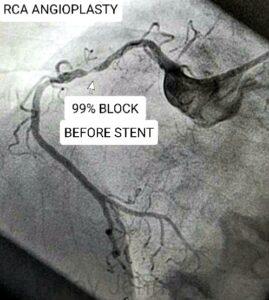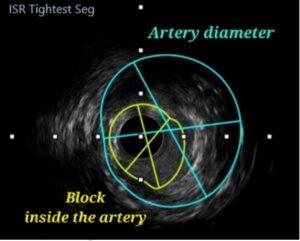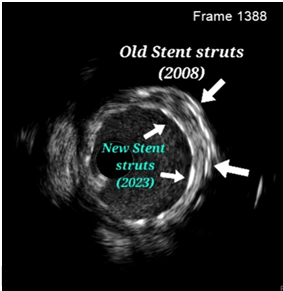What is Intra-Vascular imaging (IVI)?
Intra-Vascular Imaging (IVI) is a technology by which images can be obtained from inside the coronary artery by the use of ultra-sound waves (Intra-Vascular Ultra-Sound) or light (Optical coherence tomography). Conventionally, blocks in arteries of the heart are diagnosed with a coronary angiogram, (See image) by injecting dye into the arteries of the heart and visualizing them on live x-ray. Subsequently, angioplasty and stenting of the block are also performed with the guidance of the dye and x-ray technology. However, this has changed for the better with the advent of Intra-Vascular Imaging.
The image shows a block as seen by a conventional angiogram using dye


What is Intra-Vascular Ultra-Sound?

How is Intra-Vascular Ultra-Sound different from Optical Coherence Tomography?
The key differences between IVUS and OCT is that the former uses sound waves to generate images while the latter uses near-infrared light to generate images. Besides this, OCT requires injection of dye into the artery to clear the blood from the artery, when the images are being acquired while IVUS does not need this. This makes IVUS the imaging of choice in patients with kidney function impairment as the amount of dye that can be used in kidney failure patients needs to be limited.
What are the advantages of IVUS over a conventional angiography guided angioplasty?
IVUS also gives more precise information on the types of the blocks like the presence and percentage of fat, fibrous tissue and calcium in the blocks. Different types of blocks will need different types of balloons and hardware for successful opening of the blocks. This information from IVUS aids in selecting the appropriate balloons and hardware to be used in the angioplasty. Thus depending on the morphology, plain balloons can be selected for soft fatty tissue, cutting balloons with blades for fibrous tissue and drills like the rotablator or shock waves or intra-vascular lithotripsy or orbital atherectomy for breaking and opening calcified or rock like blocks.
Use of Intra-Vascular Ultra-Sound in treating blocks inside old stents
IVUS also aids in better treatment of blocks occurring inside the stents called In-Stent Re-stenosis (ISR), by providing information about the character of the block and also the possible mechanism why the block occurred thus enabling to select the best and ideal hard-ware and techniques to treat the ISR (See image). The image shows a tight block inside a stent placed in the patient 15 years ago. The IVUS helped in understanding the mechanism of the re-block and take precise measurements of the diameter and length of the artery thus helping in deciding stent diameter and length.
Image shows high resolution IVUS image of the artery and block inside an old stent.

Use of IVUS immediately after stenting
IVUS can also be used to see the inside of the stents after angioplasty and to see if the stents are well expanded. Poorly expanded or mal-apposed stents (See image) can cause complications like clot formation inside the stent and a resultant heart attack. The image shows a second stent used to open the block (2023) in the old stent placed in 2008. However there is a gap between the two stents, called malapposition, which can produce complications if left untreated. IVUS helped to identify this. The malapposition was subsequently treated with a bigger diameter balloon to give complete expansion and the best result to the patient.
Image shows malapposed stent struts as seen by IVUS

Image shows same under expanded stent seen in previous image, now fully expanded, after correction with a high pressure balloon.

Expertise: Dr Binoy John is highly proficient in Intra-Vascular Imaging and has been performing IVUS guided angioplasties from 2011 and has given lectures in numerous national and international interventional conferences.
Video: How does In-Stent Re-stenosis look by IVUS imaging?






